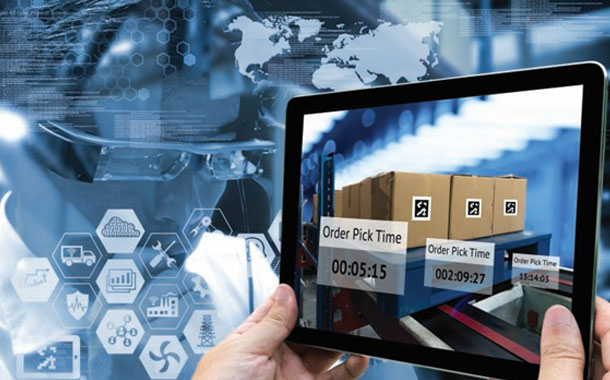CIOs are betting big on Enterprise Supply Chains are the next key market differentiator; moving on from the traditional string of individual components to a highly connected, autonomous and real time decision-making mechanism backed by technologies like AI, RPA, IoT, ML, Mobility, Cloud and Analytics.
Supply Chains run and rule the world. It can be argued that supply chain have been vital components of human societies for ages and has been the pipeline which has supported progress. By definition, a supply chain is a system of organizations, people, activities, information, and resources involved in moving a product or service from supplier to customer. It encompasses the entire process of procuring the raw materials, bringing the load to the operational lines, and further transporting the final product to the customer. With the world embracing the Digital way going forward, enterprise supply chains are transforming from structured, rigid processes to dynamic, flexible operations with real time visibility and control.
Supply chains across the globe have been rapidly transforming with the advent and introduction of digital technologies like IoT, Cloud, AI and Big Data Analytics. Enterprises today are focusing on eradicating the gaps in their supply chains and optimizing them to in turn improve margins, enable agility and reduce risk. Real time and end to end visibility is helping organizations have greater control across the entire supply chain. The surge in information and with it BI and Analytics is enabling businesses to identify gaps and rectify them in real time.
 “Technological progress has transformed supply chains from a staid cycle to a highly dynamic, interoperable system that can easily and immediately accommodate ecosystem partners and bring about an optimal evolution over time.”
Milan Kumar
Global CIO
WABCO
“Technological progress has transformed supply chains from a staid cycle to a highly dynamic, interoperable system that can easily and immediately accommodate ecosystem partners and bring about an optimal evolution over time.”
Milan Kumar
Global CIO
WABCO
Current Supply Chain Landscape and Challenges
Any business relies heavily on its supply chain to keep the processes moving. An optimized supply chain is a critical differentiator in the market today. There are a number of common challenges businesses across the world face with respect to supply chain management. Globalization has presented critical supply chain management challenges to enterprises. Growing markets and hunt for cheaper production costs have made several companies outsource aspects like manufacturing and retail. This leads to an extended supply chain that isn’t completely under control. Fast changing market trends and customer preferences have brought out shorter product lifecycles and rapid change in products come coupled with the problem of tampering the supply chain. Compliance poses another major problem as multinational companies with massive supply chains often fail to keep a check on little frauds in between and have a tough job accounting the process at each step. Digitization of the Supply Chain promises to alleviate all of these issues, giving organizations end to end visibility, real time control and transparency in their supply chain operations.
 “A successful digital supply chain has a top-bottom approach helping eradicate functional silos, augment communication and meet targets and enabling organizations to change their hybrid supply chain style into flexible digital models, giving much needed organizational elasticity.”
Arindam Singha Roy
Head IT
East India Udyog
“A successful digital supply chain has a top-bottom approach helping eradicate functional silos, augment communication and meet targets and enabling organizations to change their hybrid supply chain style into flexible digital models, giving much needed organizational elasticity.”
Arindam Singha Roy
Head IT
East India Udyog
With the customer being at the forefront of any business decision, companies have moved away for a supply driven business towards a demand driven business, constantly exploring ways to reduce inventory cost, reduce product cycle time and move product quickly and cost effectively. In today’s fast moving economy, the concept of Supply chain has emerged to be one of the important sectors across worldwide. This transformation is rooted in the rapidly increasing pace of doing business. This has given rise to digital supply chains which remove focus from process and structure to collaboration, automation, analytics and flexibility. As Arindam Singha Roy puts it, “Supply Chain Management with IT services has completely changed the outlook of how companies manage their supply Chain and how they maintain their collaborative relationships with their suppliers and satisfy the needs of their customers.”
 “The dynamism in technology products including smartphones, GPS devices, tablets and similar mobile devices has seen a steady rise in portable supply chain technology which is invaluable in monitoring the supply chains wirelessly.”
Ravinder Arora
Head Information Security
IRIS Software
“The dynamism in technology products including smartphones, GPS devices, tablets and similar mobile devices has seen a steady rise in portable supply chain technology which is invaluable in monitoring the supply chains wirelessly.”
Ravinder Arora
Head Information Security
IRIS Software
Supply chain arguably is the most critical part of any manufacturing organization. Businesses have to constantly maintain the Supply vs. Demand ratio managing and maintaining just in time requirements. The face of the supply chain has changed a lot over the last decade with the help of technology like SAP, MS Dynamics etc. As Arvind Kumar opines, “In early 2000s, we needed to plan for a quarter in advance to fulfill our daily production requirements and fulfillment ratio, stock management, and vendor / supplier management. Managing warehouses and maintaining minimum stock and relevant stock inventory involved great effort and manpower.” He continues, “But nowadays, we always work on minimum stock management and achieving JIT requirements with the help of Technology and inventory is available on just a click away. Technology isn’t just streamlining Supply chain processes but also helping resource utilization.”
For the manufacturing industry, this signals a paradigm shift. As Milan Kumar, Global CIO, WABCO explains, “Technological progress has transformed supply chains from a staid cycle to a highly dynamic, interoperable system that can easily and immediately accommodate ecosystem partners and bring about an optimal evolution over time. There has been a shift from linear supply chains to a networked, dynamic system of supply operations which will change the course of competition in the manufacturing industry.”
 “Nowadays, we always work on minimum stock management and achieving JIT requirements with inventory available just a click away. Technology isn’t just streamlining Supply Chain processes but also helping resource utilization.”
Arvind Kumar
GM IT
Elior India Catering
“Nowadays, we always work on minimum stock management and achieving JIT requirements with inventory available just a click away. Technology isn’t just streamlining Supply Chain processes but also helping resource utilization.”
Arvind Kumar
GM IT
Elior India Catering
Technologies Influencing the Transformation
Supply Chain operations drastically improved in the twenty first century with basic automation and analytics becoming household across industries. This transformation was further fuelled by widespread adoption of applications like ERP. Now with the influx of Digital Technologies, the landscape has a lot of scope for CIOs to explore applications and use cases. Cloud computing IoT, cloud, digital supply chain and machine learning are the fulfillment systems of the future for hi-tech manufacturers and have improved the operational efficiency of supply chain processes. Increasing innovation in AI, RPA and predictive analytics are altering global opinions about the supply chain concept and adding a new dimension to it. Some of the recent innovations in Supply Chain Management are Vendor Management Inventory (VMI); Electronic Data Interchange (EDI); Cross Docking; Collaborative Planning Forecasting and Replenishment (CPFR); Advanced Planning and Scheduling and Radio Frequency Identification (RFID).
 “Companies can review large amounts of data in real time to not only create better demand planning strategies but also to share it with other crucial players in the supply network to avoid bottlenecks or disruptions in the planning and production process.”
Ajay Yadav
Head IT (North)
ARIL
“Companies can review large amounts of data in real time to not only create better demand planning strategies but also to share it with other crucial players in the supply network to avoid bottlenecks or disruptions in the planning and production process.”
Ajay Yadav
Head IT (North)
ARIL
This has put Supply Chain as one of the main stream functions and among key differentiators for businesses. What started with strategies and implementations of MRP, MRP II, Production Planning, Line Balancing, ERP progressed to Advanced ERP, VMI, JIT, Integrated Supply and Demand Planning, Advanced Planning and Optimization, WMS, Transportation Management and Optimization, and statistical techniques on top down planning and bottom up planning. Connecting suppliers and customers and making the entire plan accurate to the point and then tracking the secondary sales and integrating these with production planning and procurement planning. Development in consumer technology products such as smartphones, GPS devices, and tablets have enabled a steady rise in portable supply chain technology which is cost effective in monitoring using wireless technology.
Benefits of a Digital Supply Chain
A fully digitized supply chain offers 360 degree benefits to an enterprise. Companies can assess planning, data management solutions, and production as part of their objectives and end goals. Replacing the traditional functions with connected and intelligent systems, paperless environment, IoT enabled processes and remote monitoring of the entire process. The advantages of this transformation for an enterprise are reduction in operational costs; improved efficiency through reduction of errors; greater customer satisfaction, flexibility, lesser disruptions and better informed decision making in impromptu scenarios. The technological empowerment of the supply chain is perhaps the biggest boon for the manager. As veteran CIO Parveen Kumar Sharma puts it, “The flexibility it offers to logistic managers in tracking and monitoring the entire supply chain enables decisions on the fly which averts disruptions in the supply chain.” Arvind Kumar, who head IT for an organization dealing with food products with short lifecycles sees unprecedented perks of a digital supply chain, “We have a complete and holistic over view of our business along with forecasting and better funds management via better supply chain management. GPS navigation enables us to track our shipment live and avoid any unforeseen delays. IoT is helping us maintain precise hygiene, temperature, and nutrition levels during transportation.” IoT allows collection and evaluation of data which when coupled with Analytics enables supply chain managers to make perfect predictions of demand, in turn helping in framing accurate planning strategies.
 “The benefits of digitizing the supply chain include accurate planning, cost and time optimization, improved customer service, real time visibility, accurate billing and timely transactions making the entire operation transparent and trust worthy.”
Sanjeev Kumar
Director and CIO
ApOn India
“The benefits of digitizing the supply chain include accurate planning, cost and time optimization, improved customer service, real time visibility, accurate billing and timely transactions making the entire operation transparent and trust worthy.”
Sanjeev Kumar
Director and CIO
ApOn India
An intelligent and connected supply chain brings organizational flexibility to put in place a suitable degree of centralization aimed at reducing process costs like manual labor and physical reporting. This converts into better process quality and productivity at the same time helping central master data management to avoid discrepancies. Milan Kumar who is the Global CIO at WABCO opines, “Digitizing the supply chain results in a more forward-looking approach and establishes a highly interconnected system allowing more connections and sharing of data across networks. This data allows creation of advanced analytics opportunities and the application of the data to augmented reality, cloud-based tracking and customer self-service opportunities.” With more information at disposal than ever before and connectivity at its best, helps remove communication silos enabling information to be gathered and communicated in real-time. This extensive information and easy collaboration leads to agility and effectiveness. “A successful digital supply chain has a top-bottom approach,” explains Arindham Singha Roy, “It helps eradicate functional silos, augment communication and meet targets. Technologies such as RFID, sensors, and GPS help organizations change their hybrid supply chain style into flexible digital models, giving a much needed organizational elasticity in a rapid and volatile market.”
Any technology always comes with certain quantifiable benefits and the same is true with a digital supply chain. As veteran IT Leader Sanjeev Kumar explains, “The benefits are in all areas right from Accurate Planning and inbound-outbound quantity scheduling; cost optimization to an extent of 6 %, time optimization on an average 10%, improved customer service ranging from 70% to 90%; route and delivery visibility in real time, no pilferage and no dead freight giving 1-2% gain here, no inaccurate billing and timely payment to transporters. Moreover it has made entire supply chain digital, transparent and trust worthy.” Probably no new concept is a hit till it adds value in terms of security. Digital supply chain ensures that data on exchanges like invoice timing and approval status are stored in the cloud keeping confidential financial information well protected.
Enterprise Projects and Deployments
Supply Chain transformation technologies are today being used in processes across diverse verticals right from the critical ones like BFSI, Manufacturing, Healthcare and Government, to FMCG, Education and Retail. Arvind Kumar, Head IT at Elior Catering India is investing big time in transforming the supply chain at his organization, “We are in process to rollout for our food manufacturing processes which will help us in not only managing our supply chain but also our food production; sales and distribution processes.
In the education sector, supply chain technologies are being deployed to streamline and simplify labor intensive processes like Examinations, stationary supplies and curriculum collaboration. Parveen Kumar Sharma, CTO for ICAI comments, “We are using CDS portal for the supply of student’s course material and monitoring the complete cycle from order to delivery of study material.” Ravinder Arora explains how projects like Transport Management Software are being used to enable centralized management, “It is now possible to have such a panel in your mobile device where you can organize your inventory data, manage shipping, monitor distribution and create an electronic bill of landing, all in the comfort of your office or while on the go. This enhances customer experience and reduces errors in the entire process.”
Blockchain is a remarkable concept that is being heavily explored for use cases and applications in the supply chain domain. Arindham Singha Roy of East India Udyog explains, “We are planning to do pilot on leveraging blockchain in Supply Chain as physical, financial, and digital information will be brought together in one platform to reveal sources of value leakage — from everyday inefficiencies to fraud and abuse — and helps us to adopt new strategies to combat them.” Blockchains have the ability to resolve transparency and traceability issues in processes. Moving a product from supplier to customer requires people, resources, knowledge, processes, and financial transactions. It becomes complicated to display the full picture of a large supply chain system to everyone involved. Information is distributed to various people at various times, and this data is typically stored in multiple locations which can be made accessible by implementing blockchain based solutions.
 “The flexibility technology offers to logistic managers in tracking and monitoring the entire supply chain enables them to take decision on the fly which averts disruptions in the supply chain. This results in enhancement of customer satisfaction.”
Parveen Kumar Sharma
Consultant IT and CTO
The Institute of Chartered Accountants of India
“The flexibility technology offers to logistic managers in tracking and monitoring the entire supply chain enables them to take decision on the fly which averts disruptions in the supply chain. This results in enhancement of customer satisfaction.”
Parveen Kumar Sharma
Consultant IT and CTO
The Institute of Chartered Accountants of India
Future of the Enterprise Supply Chain
In the near future, traditional supply chains will shift from being merely a support entity to a decision-making entity. Coupled with Big Data and Cloud Computing, digitizing the supply chain will empower companies with greater data gathering, reporting, and analytics capabilities. Enterprise supply chains aided by the industry 4.0 will better the understanding of customer expectations resulting in enhanced customer relationships. Digital supply chains will be able to identify risks more proactively and preventatively and mitigate them effectively. Companies will be able to review large amounts of data in real time to not only create better demand planning strategies but also share data in the moment with other crucial players in the supply network to avoid bottlenecks or disruptions at different stages in the planning and production process.
For the next 10 years, emerging supply chain roles will reflect a focus on profitability and performance improvement, as well as strong analytical skills that can leverage the algorithms and advanced simulations powered by AI and prescriptive analytics to create new value for the business. These roles will include process improvement managers, business development leads, risk managers and data scientists. The Supply Chain will be completely JIT, an initiation already executed by e-commerce companies for on demand supply from anywhere to everywhere and will lead to on demand manufacturing of products with almost zero stock management. AI is expected to be used in a big way in the SCM. Advanced AI solutions have numerous applications in the supply chain including gesture recognition solutions in the procurement process, automated warehousing, and autonomous vehicles designed to navigate without human input.
Improved speed, dynamics and resiliency of the supply chain operations leading to greater customer responsiveness will count for higher revenue and better market valuation. The major trends that will influence investment in supply chain technologies are customer satisfaction by optimized services, product shelf life, and analytical tools signaling increased focus on B2C in comparison to B2B. Impact of RPA, IoT, ML, Mobility and Mobile App enablement with real-time Cloud based analytics will enable analysis and constant fine tuning of the enterprise supply chain. The scope of value addition through supply chain transformation is rapidly increasing with newer technologies and use cases coming up every day. A digitized supply chain promises a great step towards better business in future but the quality of skills and effort required and deployed will ultimately be the key success differentiator for enterprises moving forward.
Supply Chain Transformation Trends for Enterprises
- Functional Measurement to Customer Service Measurement to Relevant Value Measurement
- Dumb Technology to Smart Technology to Automatic Technology
- Training to Knowledge Based Development to Talent Management
- Managerial Accounting to Value-based Management to Total Value Orientation
- Untenability to Sustainability to Pro-sustainability
- Customer Service to Relationship Management to Intelligent Value Co-creation
- Local Optimization to Global Optimization to Glocal Optimization
- Incremental Change to Transformational Agility to Prognostic Agility
- Risk Agnostic to Risk Management to Risk Prognosis
- Information Hoarding to Information Sharing to Information Synthesis
- Demand Forecasting to Demand Endcasting to Demand Shaping
- Vertical Integration to Virtual Integration to Flexible Network Integration
- Inertia to Innovation to Transformation
- Functional Focus to Process Focus to Systemic Focus
- Adversarial Relationships to Collaborative Relationships to Vested Relationships
Top Enterprise Supply Chain Priorities
- Reducing Operational Costs
- Improving Products and Services
- Increased/ Real Time Monitoring
- Informed Decision Making with BI
- Streamlining of Process
- Decentralizing Supply Chain Components
- Better Customer Experience
- Expanding Geographical Footprint
- Reducing Carbon Emissions
Technologies influencing Supply Chains
- 3D Printing
- Robotics
- Drones
- Big Data Analytics
- Transportation Management Systems
- Enterprise Resource Planning
- Autonomous Vehicles
- Blockchain
- Machine Learning
- Artificial Intelligence




